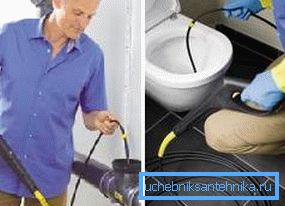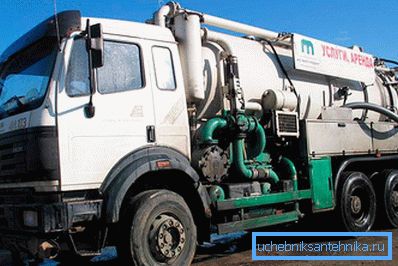Sewer well cleaning
All industrial and domestic sewage systems are equipped today with special access points (so-called wells) used for various functional needs, including emergency repair and maintenance work. In the domestic version of such wells, as a rule, are part of the special septic tanks - septic tanks used to collect sewage in suburban areas.
Effective operation of such “revisions” (regardless of their functional purpose) is impossible without constant monitoring of their working condition, as well as without timely maintenance of sewage structures.
The most important component of such activities is the cleaning of sewage wells from debris and mud sediment accumulated during the period of operation of the drain construction. As a rule, they are cleaned in the offseason, at the end of the winter operational period, accompanied by the formation of large amounts of mud and garbage. It is clear that such pollution contributes to a decrease in the throughput capacity of the sewage system and over time can lead to a partial loss of its efficiency.
Tip! In order to avoid such troubles, it is necessary to periodically clean the manholes from dirt. Modern technologies allow you to do this not only often, but also quickly.
Of all the known methods widely used in living conditions, you should choose the most affordable and most suitable option for your particular situation. But first it is advisable to familiarize yourself with the full list of existing methods for cleaning structures of this class.
The main methods of cleaning drains

Cleaning the elements of sewer systems we are considering can be organized by any of the following methods:
- With the help of special assenizatorsky mechanisms, equipped with a vacuum pump and tank tank (the so-called ilososov). Such devices are usually used for complex maintenance of collective sewer systems.
- Hydrodynamic method, the implementation of which is quite simple and allows you to do without the involvement of special mechanisms. According to this method, high-pressure water is pushed inside the well, which leads to the natural leaching of dirt from the cleaned space. At the end of cleaning, all mud waste is collected in one place and removed manually.

It should be noted that the hydrodynamic method of removing pollution belongs to the category of universal, allowing to "flush out" deposits of both organic and inorganic origin. However, the effective use of this method is possible only under the condition that the predetermined schedule of cleaning works is observed.
With regard to the involvement of special mechanisms equipped with a vacuum pump - this method involves the implementation of cleaning works in two stages. During its implementation, the sewage system is first cleaned of dirt, and then pumped out of polluted water.
Tip! Upon completion of the full cycle of cleaning works (regardless of the chosen method of removing dirt from the well), it must be manually cleaned.
Such an organization of purification measures eliminates all mechanical defects and provides for more thorough removal of sediments and sediments.
Auxiliary techniques

Heat treatment and their chemical washing can be considered as additional methods of cleaning wells. The thermal method very much resembles the hydrodynamic processing already considered earlier with the only difference that the water supplied under pressure heats up to a relatively high temperature (about 160? C).
The application of this method allows to clean the walls of pipes from various fatty deposits and other deposits of organic origin with high efficiency. Despite its effectiveness, this technique is very rarely used in the domestic environment, which is explained by the complexity of its technical implementation.
As for the chemical flushing of sewers and wells, for the implementation of this method, you need special potent reagents that can destroy the mud (fat) deposits at the molecular level. This method of sewer cleaning is also highly efficient and completely harmless to human health.
The only difficulty that can be encountered in the process of its implementation is the relatively high cost of potent chemicals.
Video
This video shows how hydrodynamic cleaning of sewage occurs: